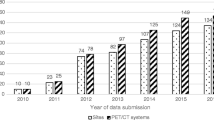Abstract
Routine quality assurance (QA) is necessary and essential to ensure MR scanner performance. This includes geometric distortion, slice positioning and thickness accuracy, high contrast spatial resolution, intensity uniformity, ghosting artefact and low contrast object detectability. However, this manual process can be very time consuming. This paper describes the development and validation of an open source tool to automate the MR QA process, which aims to increase physicist efficiency, and improve the consistency of QA results by reducing human error. The OSAQA software was developed in Matlab and the source code is available for download from http://jidisun.wix.com/osaqa-project/. During program execution QA results are logged for immediate review and are also exported to a spreadsheet for long-term machine performance reporting. For the automatic contrast QA test, a user specific contrast evaluation was designed to improve accuracy for individuals on different display monitors. American College of Radiology QA images were acquired over a period of 2 months to compare manual QA and the results from the proposed OSAQA software. OSAQA was found to significantly reduce the QA time from approximately 45 to 2 min. Both the manual and OSAQA results were found to agree with regard to the recommended criteria and the differences were insignificant compared to the criteria. The intensity homogeneity filter is necessary to obtain an image with acceptable quality and at the same time keeps the high contrast spatial resolution within the recommended criterion. The OSAQA tool has been validated on scanners with different field strengths and manufacturers. A number of suggestions have been made to improve both the phantom design and QA protocol in the future.





Similar content being viewed by others
References
Aisen AM, Martel W, Braunstein EM, McMillin KI, Phillips WA, Kling TF (1986) MRI and CT evaluation of primary bone and soft-tissue tumors. Am J Roentgenol 146:749–756
Price RR, Axel L, Morgan T, Newman R, Perman W, Schneiders N et al (1990) Quality assurance methods and phantoms for magnetic resonance imaging: report of AAPM nuclear magnetic resonance task group no. 1. Med Phys 17:287
Lerski RA, De Certaines JD (1993) II. Performance assessment and quality control in MRI by Eurospin test objects and protocols. Magn Reson Imaging 11:817–833
Phantom test guidance for the ACR MRI accreditation program, 2005
Acceptance testing and quality assurance procedures for magnetic resonance imaging facilities, Report of MR subcommittee task group 1, AAPM report No. 100, 2010
Gunter JL, Bernstein MA, Borowski BJ, Ward CP, Britson PJ, Felmlee JP et al (2009) Measurement of MRI scanner performance with the ADNI phantom. Med Phys 36:2193–2205
Ihalainen T, Sipilä O, Savolainen S (2004) MRI quality control: six imagers studied using eleven unified image quality parameters. Eur Radiol 14:1859–1865
Ihalainen TM, Lönnroth NT, Peltonen JI, Uusi-Simola JK, Timonen MH, Kuusela LJ et al (2011) MRI quality assurance using the ACR phantom in a multi-unit imaging center. Acta Oncol 50(6):966–972
Mulkern RV, Forbes P, Dewey K, Osganian S, Clark M, Wong S et al (2008) Establishment and results of a magnetic resonance quality assurance program for the pediatric brain tumor consortium. Acad Radiol 15:1099–1111
Fu L, Fonov V, Pike B, Evans AC, Collins DL (2006) Automated analysis of multi site MRI phantom data for the NIHPD project. Med Image Comput Comput Interv 2006:144–151
Site scanning instructions for use of the MR phantom for the ACR MRI accreditation program, 2000
Huff SJ (2003) Software development and automation of the American College of Radiology MR phantom testing accreditation criteria for the general electric magnetic resonance imaging whole body scanner
Fitzpatrick A (2005) Automated quality assurance for magnetic resonance image with extensions to diffusion tensor imaging
Panych LP, Bussolari L, Mulkern RV (2010) Automated analysis of ACR phantom data as an adjunct to a regular MR quality assurance program. Int Soc Magn Reson Med 5071
Schneider CA, Rasband WS, Eliceiri KW (2012) NIH Image to ImageJ: 25 years of image analysis. Nat Methods 9:671–675
Tofts P (1994) Standing waves in uniform water phantoms. J Magn Reson 104:143–147
Müller-Gärtner H, Links J, Prince J, Bryan R, McVeigh E, Leal J et al (1992) Measurement of radiotracer concentration in brain gray matter using positron emission tomography: MRI-based correction for partial volume effects. J Cereb Blood Flow Metab 12:571–583
Shattuck D, Sandor-Leahy S, Schaper K, Rottenberg D, Leahy R (2001) Magnetic resonance image tissue classification using a partial volume model. Neuroimage 13:856–876
Acknowledgments
This work was supported by Cancer Council New South Wales Research Grant RG11-05.
Conflict of interest
Authors declare no conflict of interest.
Author information
Authors and Affiliations
Corresponding author
Rights and permissions
About this article
Cite this article
Sun, J., Barnes, M., Dowling, J. et al. An open source automatic quality assurance (OSAQA) tool for the ACR MRI phantom. Australas Phys Eng Sci Med 38, 39–46 (2015). https://doi.org/10.1007/s13246-014-0311-8
Received:
Accepted:
Published:
Issue Date:
DOI: https://doi.org/10.1007/s13246-014-0311-8




